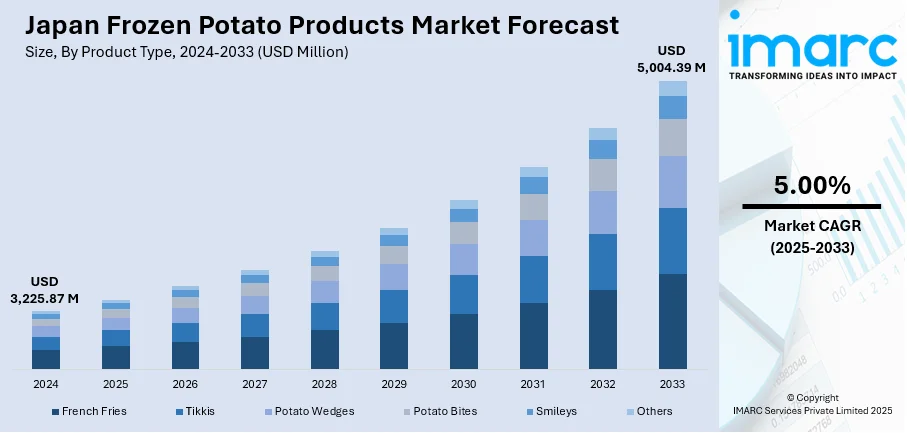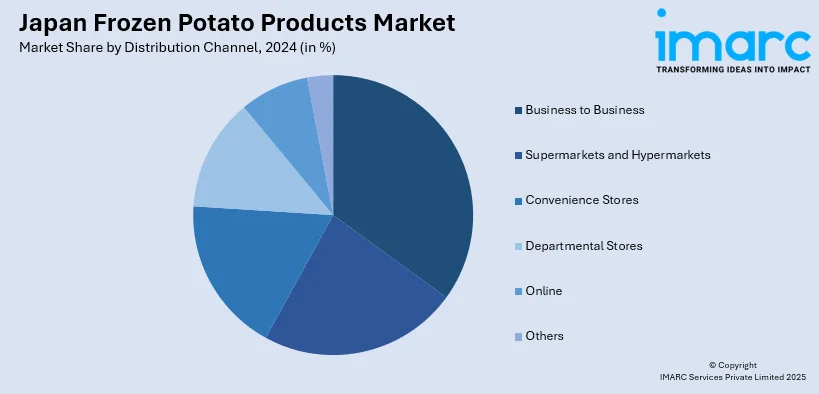
Japan Frozen Potato Products Market Size, Share, Trends and Forecast by Product Type, Distribution Channel, End-Use, and Region, 2025-2033
Japan Frozen Potato Products Market Overview:
The Japan frozen potato products market size reached USD 3,225.87 Million in 2024. Looking forward, IMARC Group expects the market to reach USD 5,004.39 Million by 2033, exhibiting a growth rate (CAGR) of 5.00% during 2025-2033. The market is being driven by the rising popularity of Western-style fast food among younger consumers and urban populations, along with structural labor shortages in the foodservice industry that are increasing reliance on convenient, pre-processed ingredients to maintain efficiency, consistency, and quality across restaurants, convenience stores, and institutional kitchens.
|
Report Attribute
|
Key Statistics
|
|---|---|
|
Base Year
|
2024
|
|
Forecast Years
|
2025-2033
|
|
Historical Years
|
2019-2024
|
| Market Size in 2024 | USD 3,225.87 Million |
| Market Forecast in 2033 | USD 5,004.39 Million |
| Market Growth Rate 2025-2033 | 5.00% |
Japan Frozen Potato Products Market Trends:
Rising Popularity of Western-Style Fast Food Culture in Japan
One of the key drivers behind the growing frozen potato products market in Japan is the increasing influence of Western-style fast food culture, particularly among younger consumers and urban populations. In recent decades, Japan has witnessed a significant shift in dietary preferences, moving from traditional Japanese meals to more Western-style diets that include burgers, fried chicken, and, French fries. International players, such as McDonald's, Burger King, and KFC, as well as local players, such as MOS Burger and Lotteria, have established themselves in Japan and rapidly expanding. These foodservice establishments are significant buyers of frozen potato products as they are convenient, offer consistent quality, and have a long shelf-life. Moreover, Western-style convenience meals have also gained popularity in supermarkets, convenience stores (such as Lawson, FamilyMart, and 7-Eleven), and even school cafeterias. As such, frozen potato products like wedges, crinkle fries, and hash browns are now widely available as ready-to-eat or heat-and-eat products.

To get more information on this market, Request Sample
Structural Labor Shortages in the Japanese Foodservice Industry
Another factor is the country's escalating shortage of labor, specifically in the foodservice and hospitality industries. Japan has one of the world's oldest demographics, with almost 30% of its population aged over 65. This has resulted in a declining workforce and increasing challenges in finding staff for labor-intensive establishments, such as restaurants, cafes, and institutional catering services. Frozen potato products provide a convenient solution to this problem by minimizing the requirement for labor-intensive food preparation. Unlike potatoes, frozen offerings are partially prepared, partially cooked, and in many cases seasoned, cutting kitchen preparation time. Restaurants and foodservice establishments can achieve consistency and quality with fewer experienced kitchen employees, hence saving on training requirements and operating pressures. This benefit is most crucial to small- and medium-sized food operations and convenience store kitchen facilities, which usually function on reduced manpower.
Japan Frozen Potato Products Market Segmentation:
IMARC Group provides an analysis of the key trends in each segment of the market, along with forecasts at the region/country level for 2025-2033. Our report has categorized the market based on product type, distribution channel, and end-use.
Product Type Insights:
- French Fries
- Tikkis
- Potato Wedges
- Potato Bites
- Smileys
- Others
The report has provided a detailed breakup and analysis of the market based on the product type. This includes French fries, tikkis, potato wedges, potato bites, smileys, and others.
Distribution Channel Insights:

- Business to Business
- Supermarkets and Hypermarkets
- Convenience Stores
- Departmental Stores
- Online
- Others
A detailed breakup and analysis of the market based on the distribution channel have also been provided in the report. This includes business to business, supermarkets and hypermarkets, convenience stores, departmental stores, online, and others.
End-Use Insights:
- Food Services
- Retail
The report has provided a detailed breakup and analysis of the market based on the end-use. This includes food services and retail.
Regional Insights:
- Kanto Region
- Kansai/Kinki Region
- Central/Chubu Region
- Kyushu-Okinawa Region
- Tohoku Region
- Chugoku Region
- Hokkaido Region
- Shikoku Region
The report has also provided a comprehensive analysis of all the major regional markets, which include Kanto Region, Kansai/Kinki Region, Central/Chubu Region, Kyushu-Okinawa Region, Tohoku Region, Chugoku Region, Hokkaido Region, and Shikoku Region.
Competitive Landscape:
The market research report has also provided a comprehensive analysis of the competitive landscape. Competitive analysis such as market structure, key player positioning, top winning strategies, competitive dashboard, and company evaluation quadrant has been covered in the report. Also, detailed profiles of all major companies have been provided.
Japan Frozen Potato Products Market News:
- January 2025: Calbee Inc. and JA Shiretoko Shari partnered to secure a stable potato supply and enter the frozen food market. They plan to build a JPY 20 billion frozen processing facility in Hokkaido, operational by fiscal 2027, to produce items like Poterico. This initiative aims to boost local agriculture, create jobs, and help Calbee reach its goal of sourcing over 400,000 tons of domestic potatoes annually by 2030.
- January 2025: Calbee Inc. inaugurated its Setouchi Hiroshima Factory, marking its first new Japanese facility in nearly two decades. Innovations include converting potato residues into biogas for steam generation and reusing frying process steam for washing potatoes. Among other items, this facility is also expected to focus on frozen potato products.
Japan Frozen Potato Products Market Report Coverage:
| Report Features | Details |
|---|---|
| Base Year of the Analysis | 2024 |
| Historical Period | 2019-2024 |
| Forecast Period | 2025-2033 |
| Units | Million USD |
| Scope of the Report |
Exploration of Historical Trends and Market Outlook, Industry Catalysts and Challenges, Segment-Wise Historical and Future Market Assessment:
|
| Product Types Covered | French Fries, Tikkis, Potato Wedges, Potato Bites, Smileys, Others |
| Distribution Channels Covered | Business to Business, Supermarkets and Hypermarkets, Convenience Stores, Departmental Stores, Online, Others |
| End-Uses Covered | Food Services, Retail |
| Regions Covered | Kanto Region, Kansai/Kinki Region, Central/Chubu Region, Kyushu-Okinawa Region, Tohoku Region, Chugoku Region, Hokkaido Region, Shikoku Region |
| Customization Scope | 10% Free Customization |
| Post-Sale Analyst Support | 10-12 Weeks |
| Delivery Format | PDF and Excel through Email (We can also provide the editable version of the report in PPT/Word format on special request) |
Key Questions Answered in This Report:
- How has the Japan frozen potato products market performed so far and how will it perform in the coming years?
- What is the breakup of the Japan frozen potato products market on the basis of product type?
- What is the breakup of the Japan frozen potato products market on the basis of distribution channel?
- What is the breakup of the Japan frozen potato products market on the basis of end-use?
- What is the breakup of the Japan frozen potato products market on the basis of region?
- What are the various stages in the value chain of the Japan frozen potato products market?
- What are the key driving factors and challenges in the Japan frozen potato products market?
- What is the structure of the Japan frozen potato products market and who are the key players?
- What is the degree of competition in the Japan frozen potato products market?
Key Benefits for Stakeholders:
- IMARC’s industry report offers a comprehensive quantitative analysis of various market segments, historical and current market trends, market forecasts, and dynamics of the Japan frozen potato products market from 2019-2033.
- The research report provides the latest information on the market drivers, challenges, and opportunities in the Japan frozen potato products market.
- Porter's five forces analysis assist stakeholders in assessing the impact of new entrants, competitive rivalry, supplier power, buyer power, and the threat of substitution. It helps stakeholders to analyze the level of competition within the Japan frozen potato products industry and its attractiveness.
- Competitive landscape allows stakeholders to understand their competitive environment and provides an insight into the current positions of key players in the market.
Need more help?
- Speak to our experienced analysts for insights on the current market scenarios.
- Include additional segments and countries to customize the report as per your requirement.
- Gain an unparalleled competitive advantage in your domain by understanding how to utilize the report and positively impacting your operations and revenue.
- For further assistance, please connect with our analysts.
 Request Customization
Request Customization
 Speak to an Analyst
Speak to an Analyst
 Request Brochure
Request Brochure
 Inquire Before Buying
Inquire Before Buying




.webp)




.webp)












